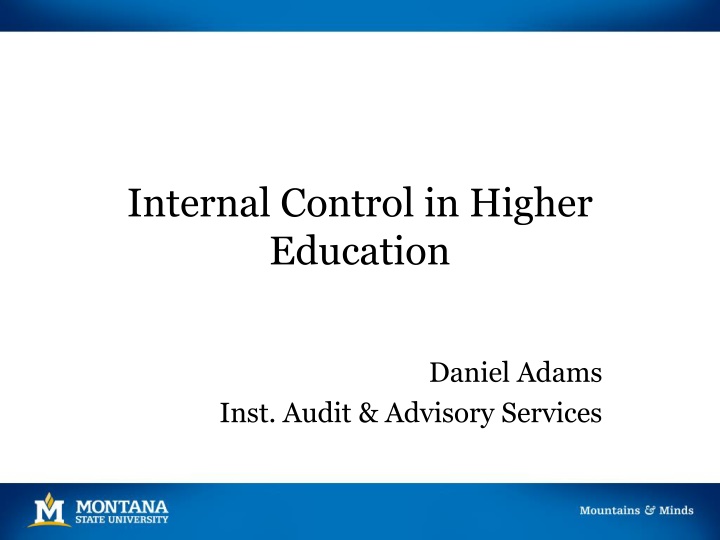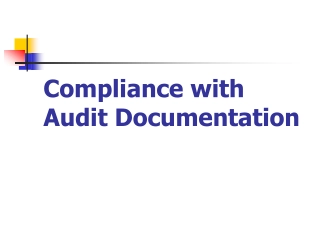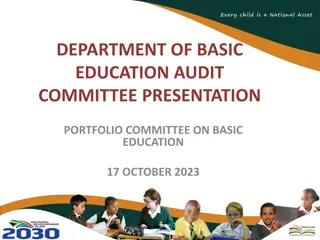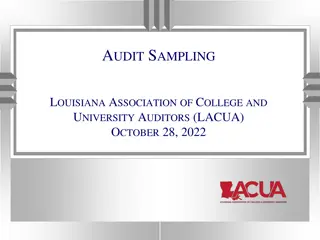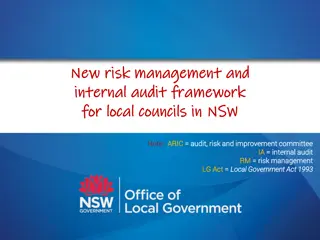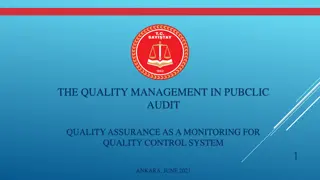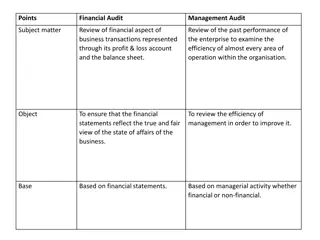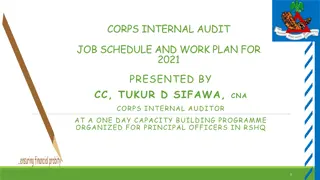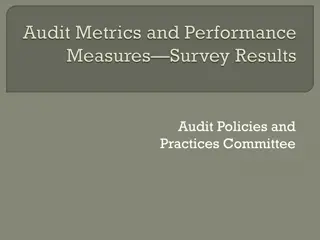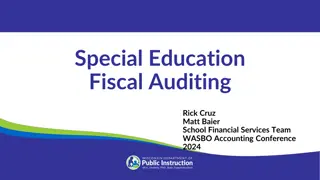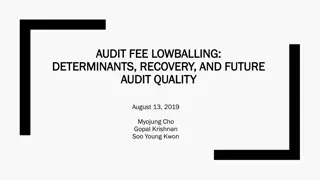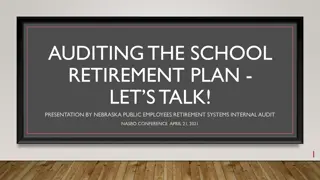Internal Control in Higher Education: Audit & Advisory Services Overview
Importance of internal control processes in higher education, including compliance monitoring, risk management, and asset safeguarding. Learn about frameworks like COSO and OMB Circular A-81 that guide these controls.
Download Presentation

Please find below an Image/Link to download the presentation.
The content on the website is provided AS IS for your information and personal use only. It may not be sold, licensed, or shared on other websites without obtaining consent from the author.If you encounter any issues during the download, it is possible that the publisher has removed the file from their server.
You are allowed to download the files provided on this website for personal or commercial use, subject to the condition that they are used lawfully. All files are the property of their respective owners.
The content on the website is provided AS IS for your information and personal use only. It may not be sold, licensed, or shared on other websites without obtaining consent from the author.
E N D
Presentation Transcript
Internal Control in Higher Education Daniel Adams Inst. Audit & Advisory Services
About IAAS Evaluate (internal) control processes Monitor: Compliance with policies, procedures laws and regulations Means of safeguarding assets Effectiveness and efficiency Risk management processes Quality and continuous improvement in operations Investigate suspected fiscal misconduct Source: http://www.montana.edu/audit/iaas_charter.html
Internal Control in HE Overview 5 elements and 17 principles of internal control Areas where internal control processes should commonly be implemented in HE Tools for assessing and improving internal control processes in your unit
Office of Management and Budget (OMB) Circular A-81 200.303 Internal controls. control over the Federal award that provides reasonable assurance that the non-Federal entity is managing the Federal award in compliance with Federal statutes, regulations, and the terms and conditions of the Federal award. The non-Federal entity must: (a) Establish and maintain effective internal
OMB Circular A-81 200.303 Internal controls. These internal controls should be in compliance with guidance in Standards for Internal Control in the Federal Government issued by the Comptroller General of the United States and the Internal Control Integrated Framework , issued by the Committee of Sponsoring Organizations of the Treadway Commission (COSO).
COSO Internal ControlIntegrated Framework COSO (Committee of Sponsoring Organizations) of the Treadway Commission American Accounting Association (AAA) American Institute of Certified Public Accountants (AICPA) Financial Executives International (FEI) Institute of Management Accountants (IMA) The Institute of Internal Auditors (IIA)
The Green Book Standards for Internal Control in the Federal Government Government Accountability Office (GAO) Comptroller General of the United States May also be adopted by state, local, and quasi-governmental entities as a framework for an internal control system Source: Standards for Internal Control in the Federal Government. GAO. September 2014.
Other Internal Control Frameworks Canadian Institute of Chartered Accountants Control Framework Control Objectives for Information and Related Technology (COBIT) International Organization for Standardization (ISO)
COSO Internal Control Definition Internal control is a process, effected by an entity s board of directors, management, and other personnel, designed to provide reasonable assurance regarding the achievement of objectives relating to operations, reporting, and compliance. Source: COSO Internal Control Integrated Framework. May 2013.
Green Book Internal Control Definition Internal control is a process effected by an entity s oversight body, management, and other personnel that provides reasonable assurance that the objectives of an entity will be achieved. Source: Standards for Internal Control in the Federal Government. GAO. September 2014.
Green Book Internal Control Definition These objectives and related risks can be broadly classified into one or more of the following three categories: Operations - Effectiveness and efficiency of operations Reporting - Reliability of reporting for internal and external use Compliance - Compliance with applicable laws and regulations Source: Standards for Internal Control in the Federal Government. GAO. September 2014.
OMB Circular A-81 200.303 Internal controls. and the terms and conditions of the Federal awards. (b) Comply with Federal statutes, regulations,
Green Book Internal Control Definition Internal control comprises the plans, methods, policies, and procedures used to fulfill the mission, strategic plan, goals, and objectives of the entity. Source: Standards for Internal Control in the Federal Government. GAO. September 2014.
Green Book Internal Control Definition Internal control serves as the first line of defense in safeguarding assets. Source: Standards for Internal Control in the Federal Government. GAO. September 2014.
Green Book Internal Control Definition In short, internal control helps managers achieve desired results through effective stewardship of public resources. Source: Standards for Internal Control in the Federal Government. GAO. September 2014.
International Organization for Standardization (ISO) Control Definition Administrative, managerial, technical or legal methods for managing risk, including policies, procedures, guidelines, practices or organizational structures Source: ISO 27000 Information security management systems.
ISO Risk Definition Combination of the probability (likelihood) of an event and its consequence (impact) Source: ISO 27000 Information security management systems.
Green Book Internal Control Definition People are what make internal control work. Management is responsible for an effective internal control system. However, personnel throughout an entity play important roles in implementing and operating an effective internal control system. Source: Standards for Internal Control in the Federal Government. GAO. September 2014.
Characteristics of Higher Education Large organizations Offices with functional (e.g., finance, HR) expertise Decentralized Partially taxpayer funded Highly regulated Some managers do not have prior business-type experience
17 Principles Support the Five Components
Control Environment The oversight body and management establish and maintain an environment throughout the entity that sets a positive attitude toward internal control. Source: Standards for Internal Control in the Federal Government. GAO. September 2014.
Control Environment - Principle 1 The oversight body and management demonstrate a commitment to integrity and ethical values. 1. 2. Standards of Conduct 3. Adherence to Standards of Conduct Tone at the Top Source: Standards for Internal Control in the Federal Government. GAO. September 2014.
What do you think about MSUs commitment to integrity and ethical values?
MSU Compliance Hotline Montana State University s four campuses are committed to acting with integrity in their pursuit of excellence. As part of this commitment, the university has selected a private contractor, EthicsPoint, to provide an independent avenue for confidential reporting of concerns about suspected legal, regulatory or policy violations. www.msucompliancehotline.ethicspoint.com
Reporting Suspected Legal, Regulatory and Policy Violations Montana State University encourages all faculty, staff, students, and volunteers, acting in good faith, to report suspected legal, regulatory or policy violations. The university is committed to protecting individuals from retaliation for making a good faith report. http://www.montana.edu/policy/reporting-violations/
Fiscal Misconduct Policy Any employee or student associated with the University who knows of or suspects fiscal misconduct should promptly notify one of the following: the director of Institutional Audit & Advisory Services, Legal Counsel, or director of University Police. http://www.montana.edu/policy/fiscal_misconduct/a udit100.html
Control Environment - Principle 2 The oversight body should oversee the entity s internal control system. 1. 2. Oversight for the Internal Control System 3. Input for Remediation of Deficiencies Oversight Structure Source: Standards for Internal Control in the Federal Government. GAO. September 2014.
How do MSUs oversight bodies oversee the internal control system?
How do they provide input for remediation of deficiencies?
BOR Policy 930.1 Internal Audit Reports An internal audit report for a campus of the Montana University System shall be provided to the Commissioner's Office when the report contains a conclusion that there has been or may have been a violation of institutional or system policy or of state or federal law. http://www.mus.edu/borpol/bor900/9301.htm
Montana Code Annotated (MCA) 5-13-309. Information from state agencies. notify both the attorney general and the legislative auditor in writing upon the discovery of any theft, actual or suspected, involving state money or property under that agency's control or for which the agency is responsible. [ ] (3) The head of each state agency shall immediately http://leg.mt.gov/bills/mca/5/13/5-13-309.htm
Control Environment - Principle 3 Management should establish an organizational structure, assign responsibility, and delegate authority to achieve the entity s objectives. 1. 2. Assignment of Responsibility and Delegation of Authority 3. Documentation of the Internal Control System Organizational Structure Source: Standards for Internal Control in the Federal Government. GAO. September 2014.
Do you think authority and responsibility are clearly assigned at MSU?
Principal Investigator Guide 710.00 Responsibilities of the PI in Post-Award Administration. 720.00 Role of Departmental Business Managers/Accountants in Post-Award Administration. 730.00 Role of OSP in Post-Award Administration. http://www.montana.edu/research/osp/piguide/700.00.html
Do you have the authority to ensure that your unit is in compliance with policies, laws and regulations?
Documentation of the Control System Establishing and communicating who, what, when, where and why of internal control execution to personnel Means to retain organizational knowledge that could be limited to a few personnel Means to communicate effective control design to outside parties (e.g., auditors) Source: Standards for Internal Control in the Federal Government. GAO. September 2014.
Guidance on Adequate Documentation Departmental Revenue Collection Procedures Model This document should be used by departments as a guide for the development or enhancement of their revenue collection procedures and should be tailored to each department s specific situation. http://www.montana.edu/audit/guidance.html
Control Environment - Principle 4 Management should demonstrate a commitment to recruit, develop, and retain competent individuals. 1. 2. Recruitment, Development, and Retention of Individuals 3. Succession and Contingency Plans and Preparation Expectations of Competence Source: Standards for Internal Control in the Federal Government. GAO. September 2014.
How does MSU do at developing and training its people?
How does MSU do at providing incentives to motivate and retain people?
Control Environment - Principle 5 Management should evaluate performance and hold individuals accountable for their internal control responsibilities. 1. 2. Consideration of Excessive Pressures Enforcement of Accountability Source: Standards for Internal Control in the Federal Government. GAO. September 2014.
Could people at MSU be feeling excessive pressures that could lead to corner cutting?
Risk Assessment Management assesses the risks facing the entity as it seeks to achieve its objectives. This assessment provides the basis for developing appropriate risk responses. Source: Standards for Internal Control in the Federal Government. GAO. September 2014.
